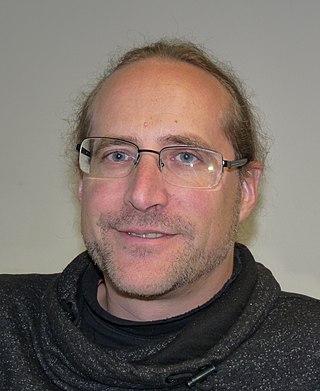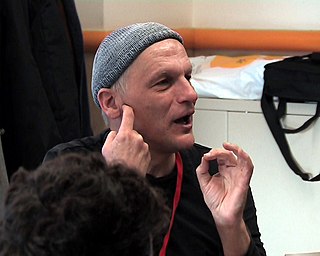Visual poetry is a style of poetry that incorporates graphic and visual design elements to convey its meaning. This style combines visual art and written expression to create new ways of presenting and interpreting poetry.
Digital poetry is a form of electronic literature, displaying a wide range of approaches to poetry, with a prominent and crucial use of computers. Digital poetry can be available in form of CD-ROM, DVD, as installations in art galleries, in certain cases also recorded as digital video or films, as digital holograms, on the World Wide Web or Internet, and as mobile phone apps.

Jaka Železnikar is a Slovenian artist known for his computational poetry and internet art. The base of his work is a nonlinear language-based expression combined with visual art. Since 1997 he has been part of the net art community, and since 2004 he has created several expressive add-ons for the Firefox browser.

Valéry Grancher is a French Internet-based artist, performer, theorist, curator and lecturer.
Islamic poetry is a form of spoken word written & recited by Muslims. Islamic poetry, and notably Sufi poetry, has been written in many languages including Urdu and Turkish.

Caterina Davinio is an Italian poet, novelist and new media artist. She is the author of works of digital art, net.art, video art and was the creator of Italian Net-poetry in 1998.
Net-poetry is a development of net.art, involving poetry. This kind of experimental art was born in several different cities and countries around 1995.

Gianni Toti was an Italian poet, writer, journalist, and cineaste. In the early 80s he created "Poetronica".

Philadelpho Menezes. Brazilian poet, visual poet, pioneer of new media poetry, professor in the Communication and Semiotics post-graduation program at the Pontifical University of São Paulo. He performed research for his post-graduate degree at the University of Bologna, in Italy (1990). With Brazilian artist Wilton Azevedo Philadepho Menezes created a pioneer intermedia-poetry CD-ROM: "InterPoesia. Poesia Hipermidia Interativa" (1998). In Italy he collaborated with the first net-poetry project: Karenina.it, by Italian artist Caterina Davinio.
Eugenio Miccini was an Italian artist and writer, considered to be one of the fathers of Italian visual poetry.
Lamberto Pignotti is an Italian poet, writer and visual artist.
Poetry film is a subgenre of film that fuses the use of spoken word poetry, visual images, and sound. This fusion of image and spoken word creates what William Wees called the "Poetry-film" genre. He suggested that "a number of avant-garde film and video makers have created a synthesis of poetry and film that generates associations, connotations and metaphors neither the verbal nor the visual text would produce on its own".

Internet art is a form of new media art distributed via the Internet. This form of art circumvents the traditional dominance of the physical gallery and museum system. In many cases, the viewer is drawn into some kind of interaction with the work of art. Artists working in this manner are sometimes referred to as net artists.

Christian Ide Hintze was an Austrian poet and performance artist, who focused on the transition from literary to cross-media forms.
Tom Konyves is a Canadian poet, video producer, educator and a pioneer in the field of videopoetry. He teaches creative visual writing at the University of the Fraser Valley.
Poet Loss Pequeño Glazier is the creator of books of print poetry, digital poems, theoretical texts, and performance works. Glazier stands among literary figures at the "forefront of the digital poetics movement. A "distinguished writer of electronic poetry as well as a critic", according to N. Katherine Hayles, he is author of Luna Lunera, Anatman, Pumpkin Seed, Algorithm, Digital Poetics: the Making of E-Poetries, the first book-length study of digital poetry, and Small Press, as well as the major digital works, white faced bromeliads on 20 hectares, Io Sono at Swoons, and Territorio Libre (2003-2010). These three works are featured in his digital poetry performance film, Middle Orange | Media Naranja. His projects also include numerous poems, essays, film, visual art, sound, digital works, and projects for dance, music, installations, and performance. Glazier's poetic vision was the subject of an interview by David Jhave Johnston in 2012. His recent project, Luna Lunera: Poems al-Andalus is a ten-year project culminating in a collection of print poetry drawn from scores of digital, code, and performance iterations. Luna Lunera is co-presented on the Web as digital poems, solo readings and as dance performances.
Olivier Auber is a French independent artist and researcher. He is best known for his project "Poietic Generator" and for having introduced the concept of "Digital Perspective" in the fields of network theory, art, and digital humanities.

Giovanni Fontana is an Italian poet, performance artist, author and publisher.

Signalism represents an international neo-avant-garde literary and art movement. It gathered wider support base both in former Yugoslavia and the world in the late 1960s and the beginning of the 1970s.







